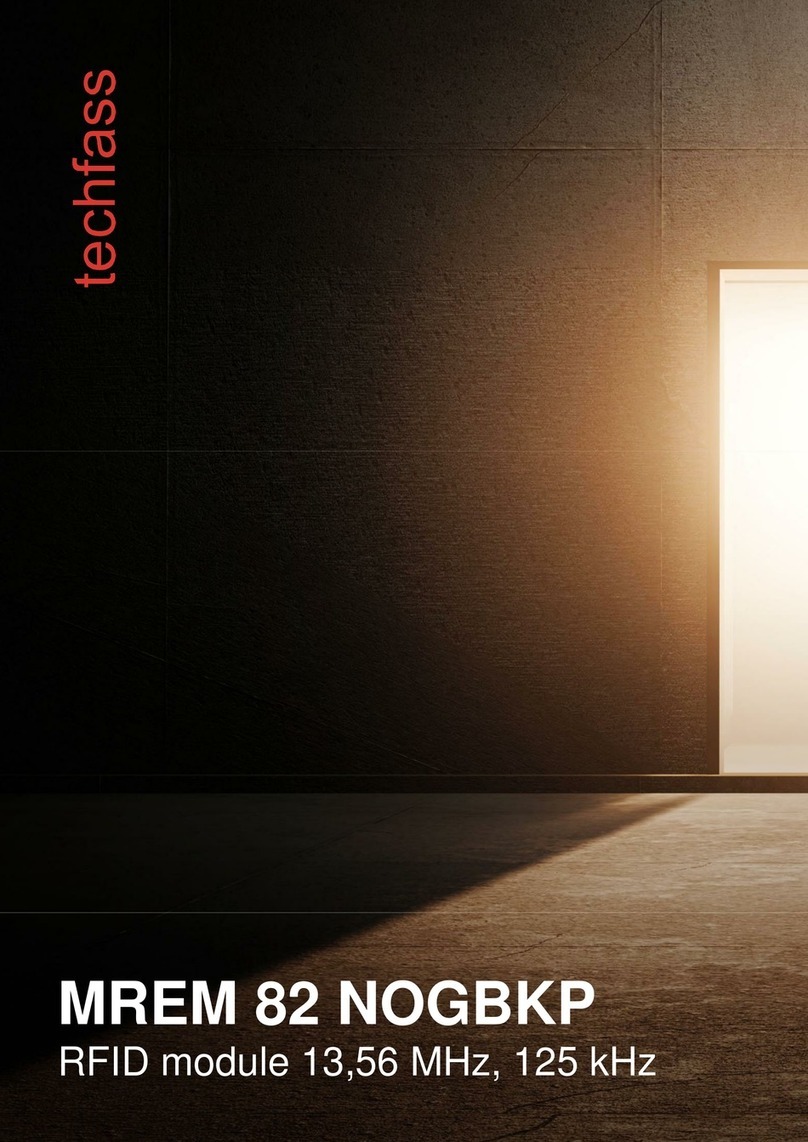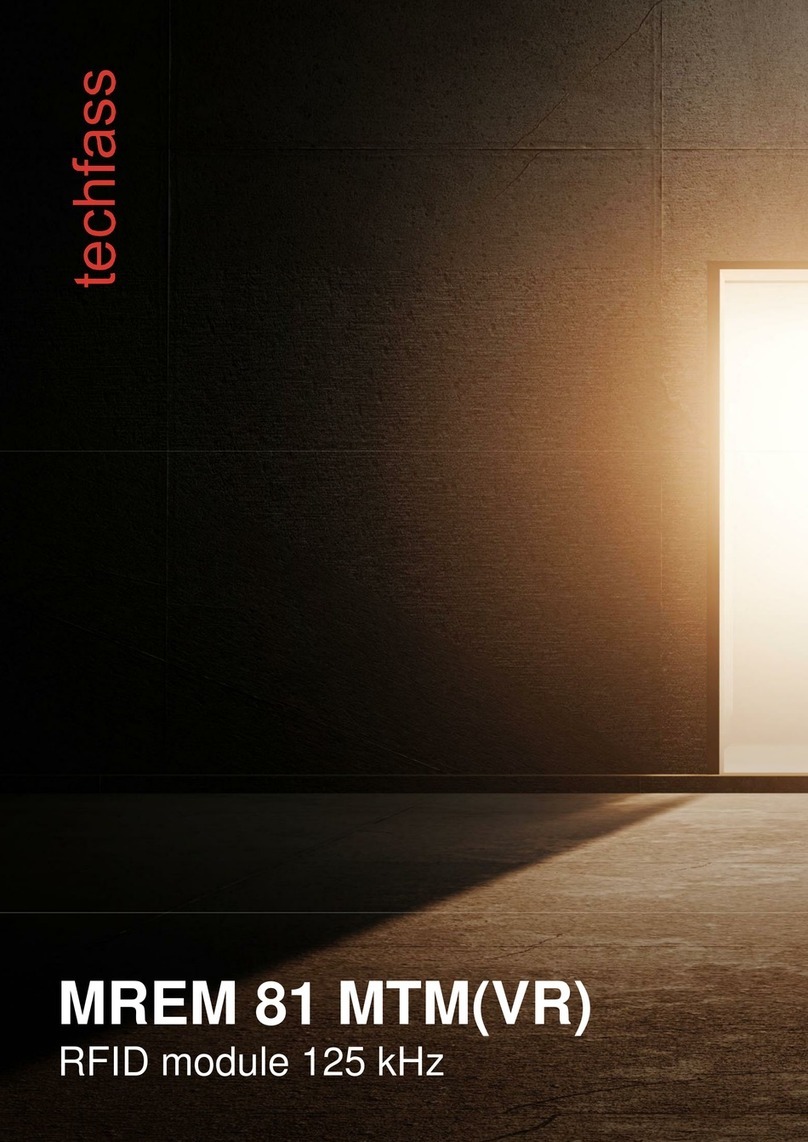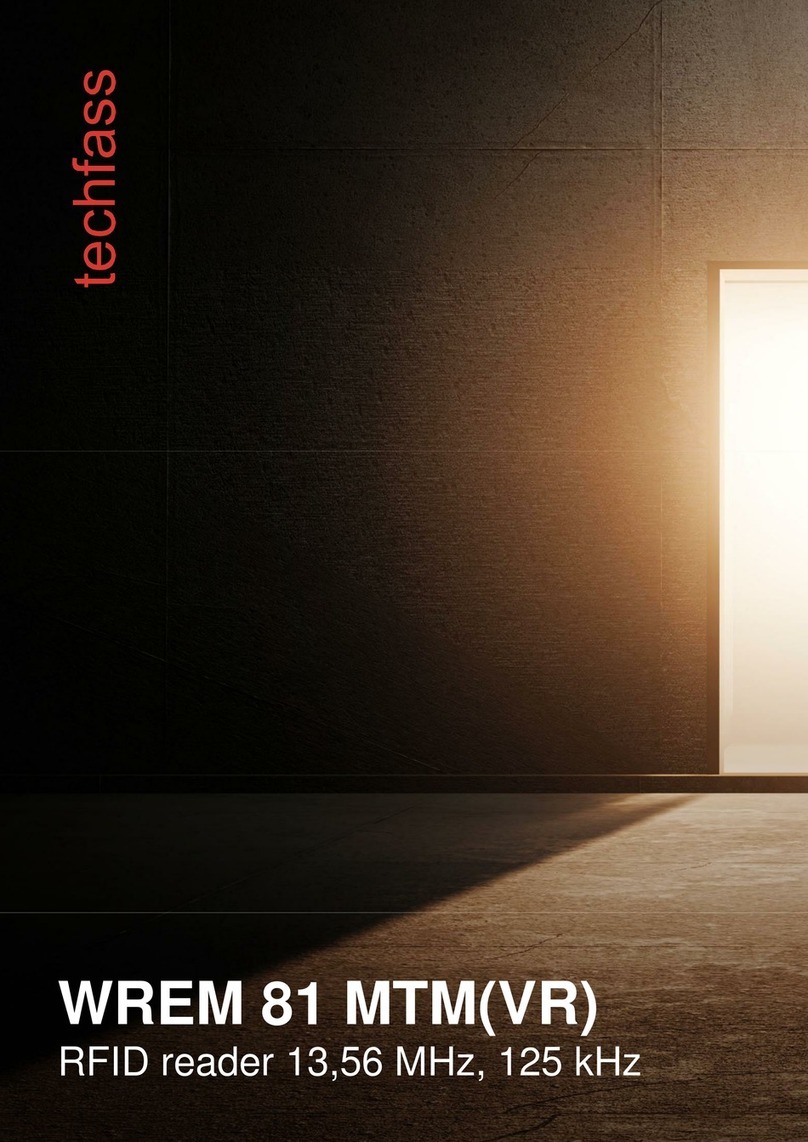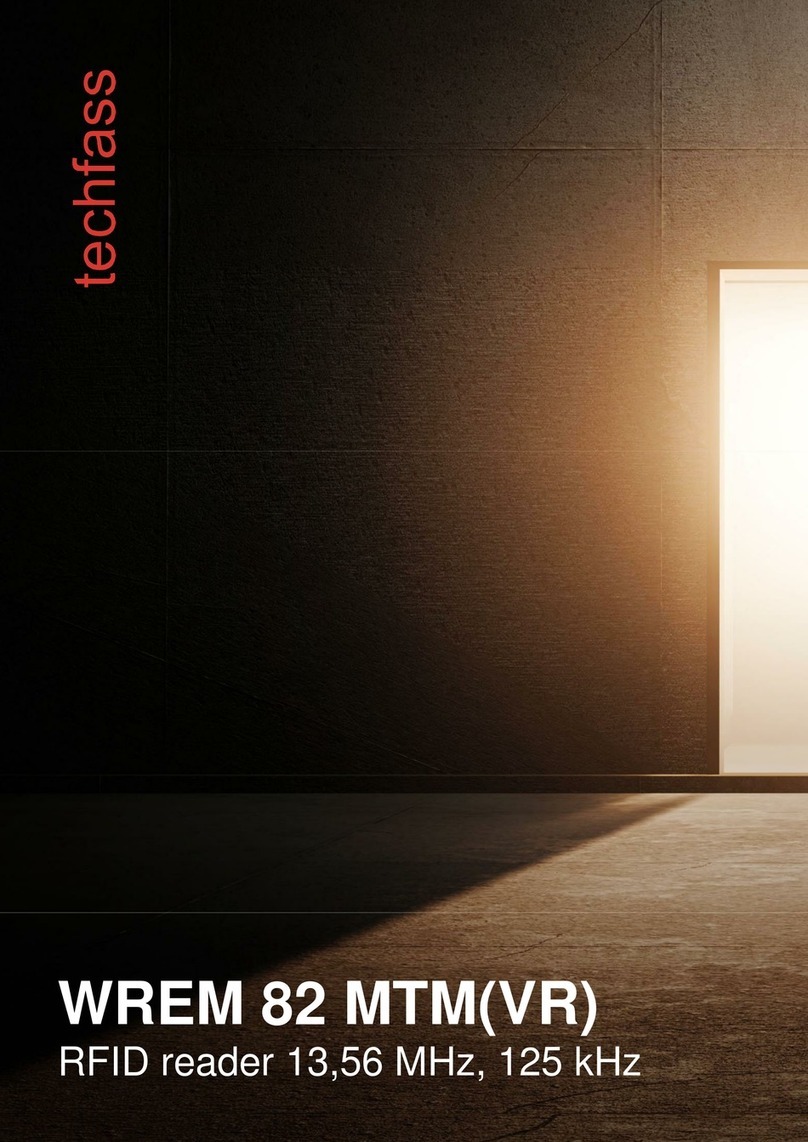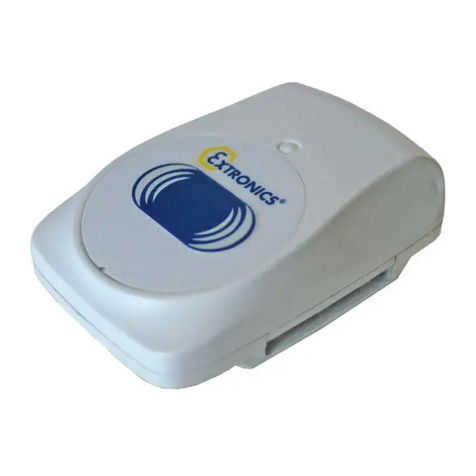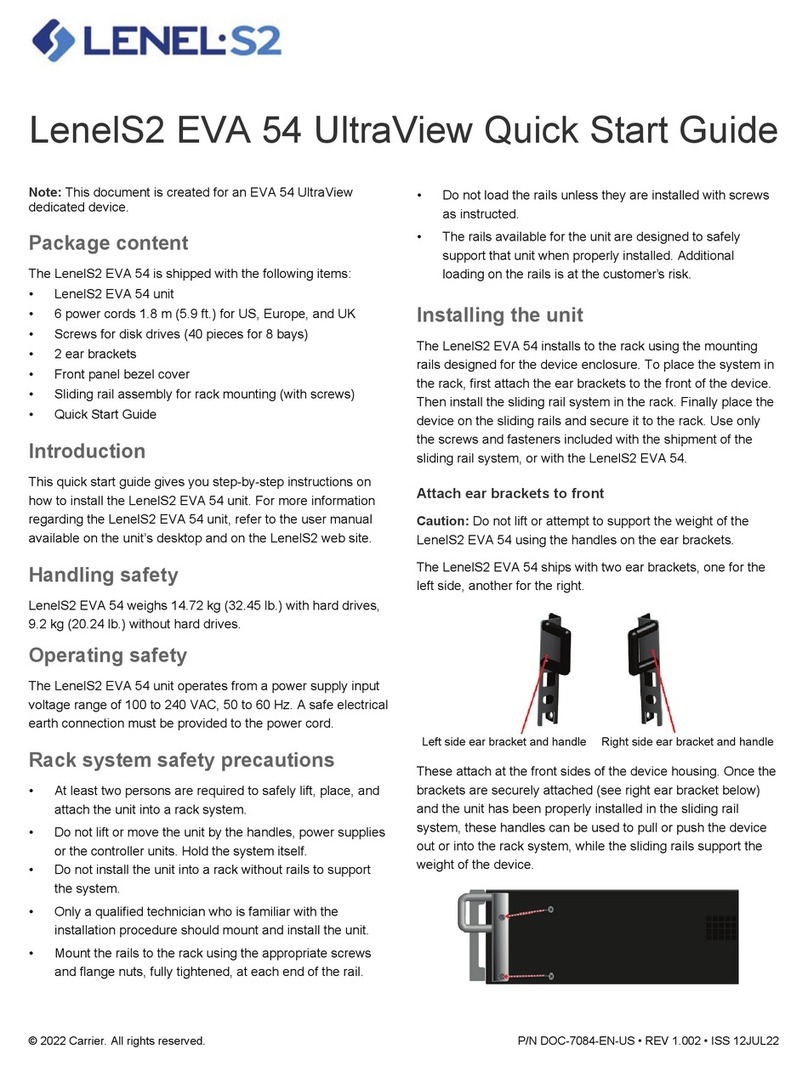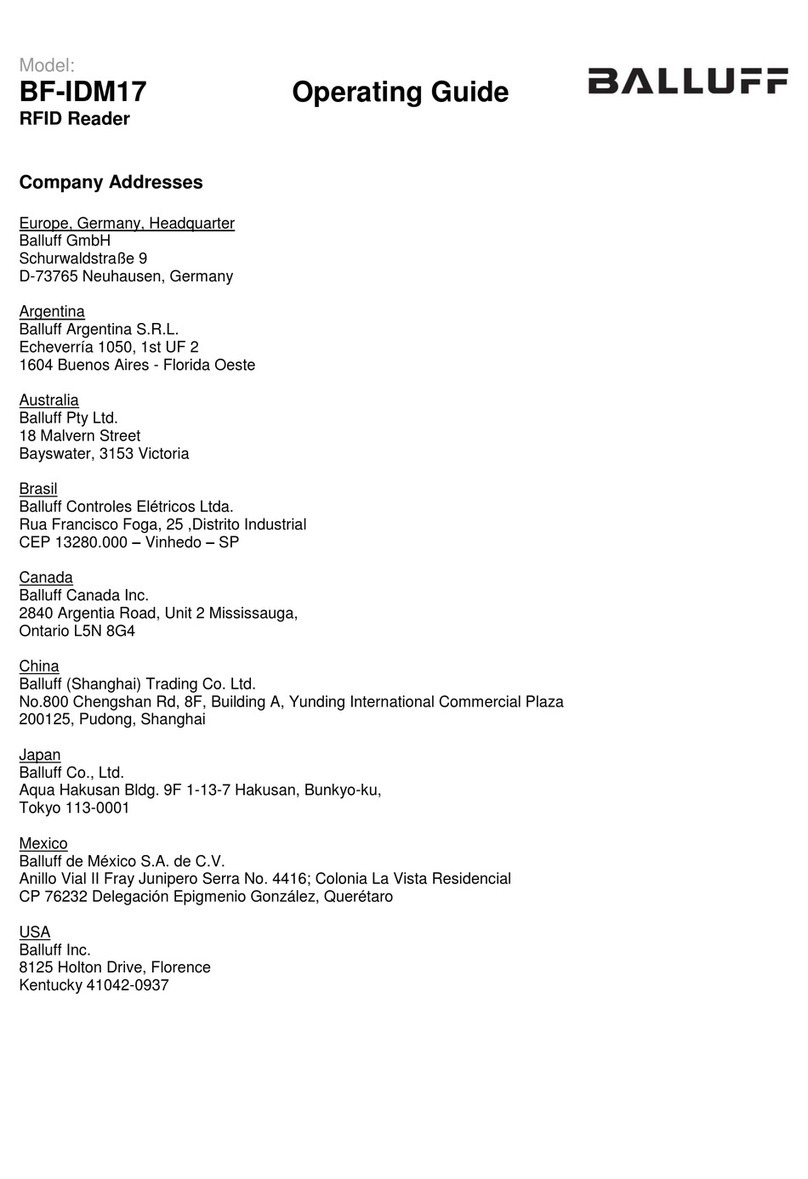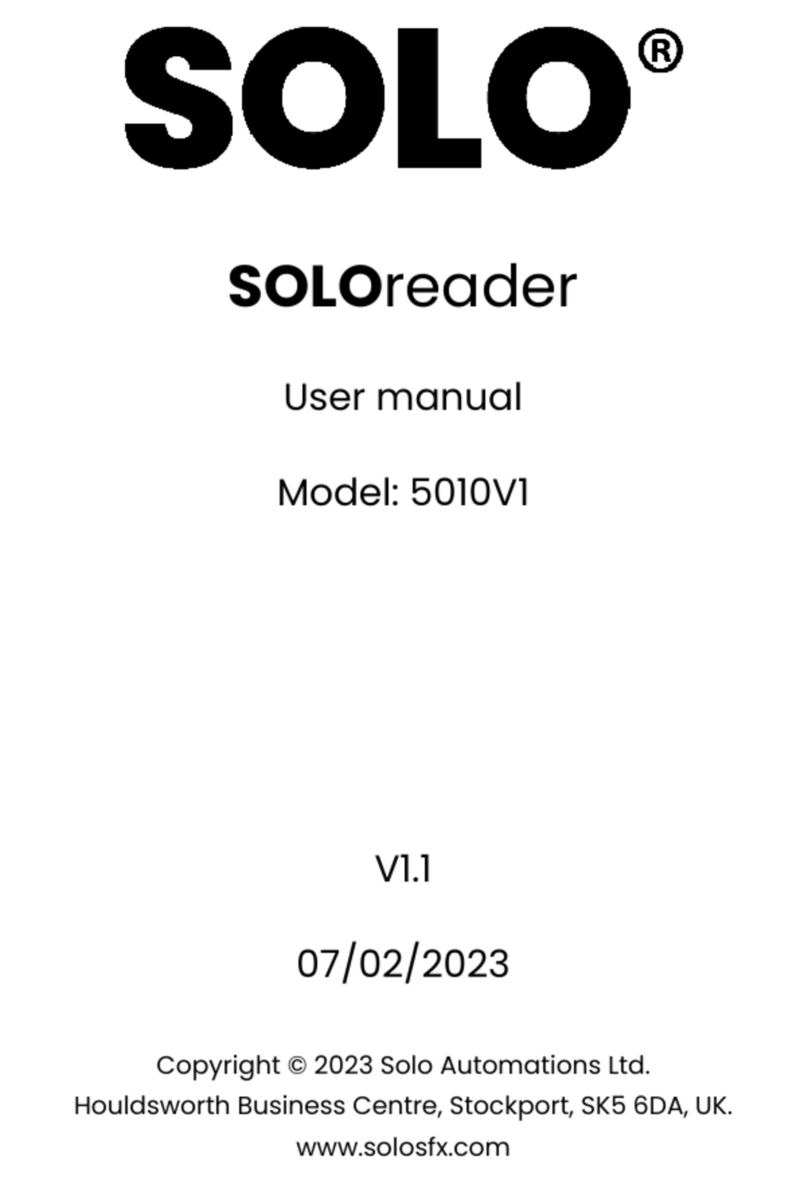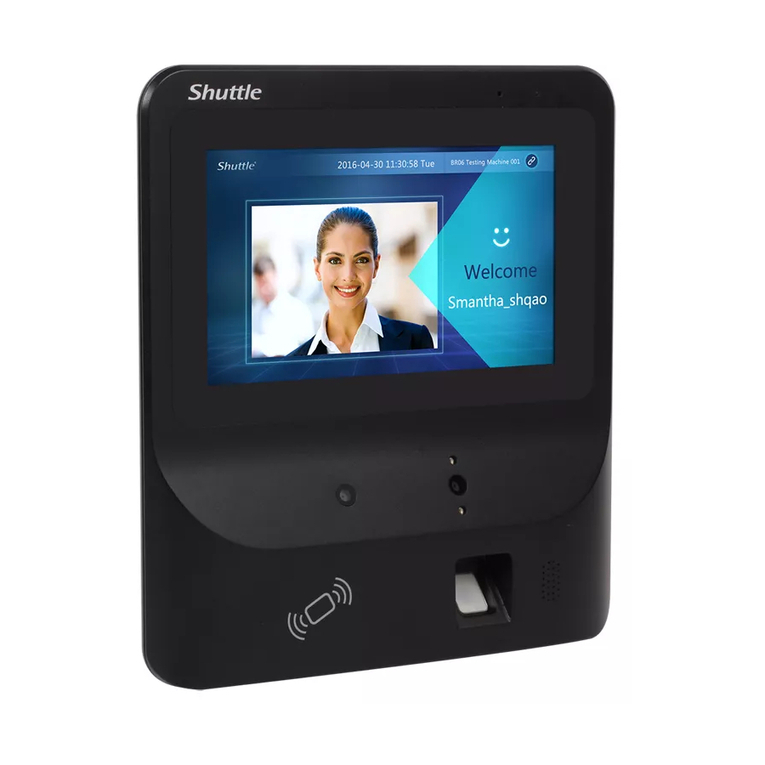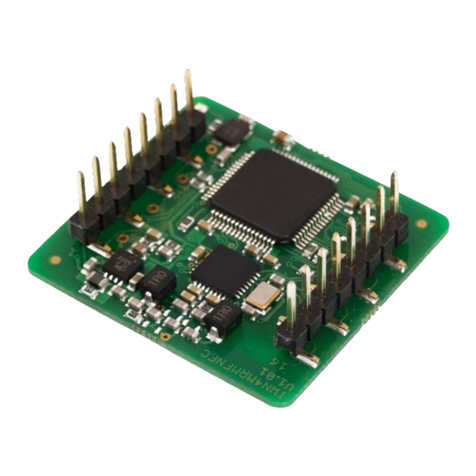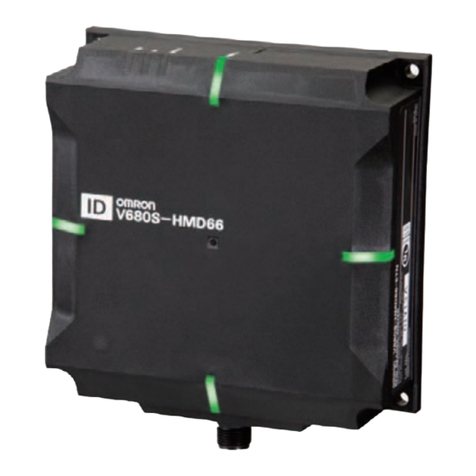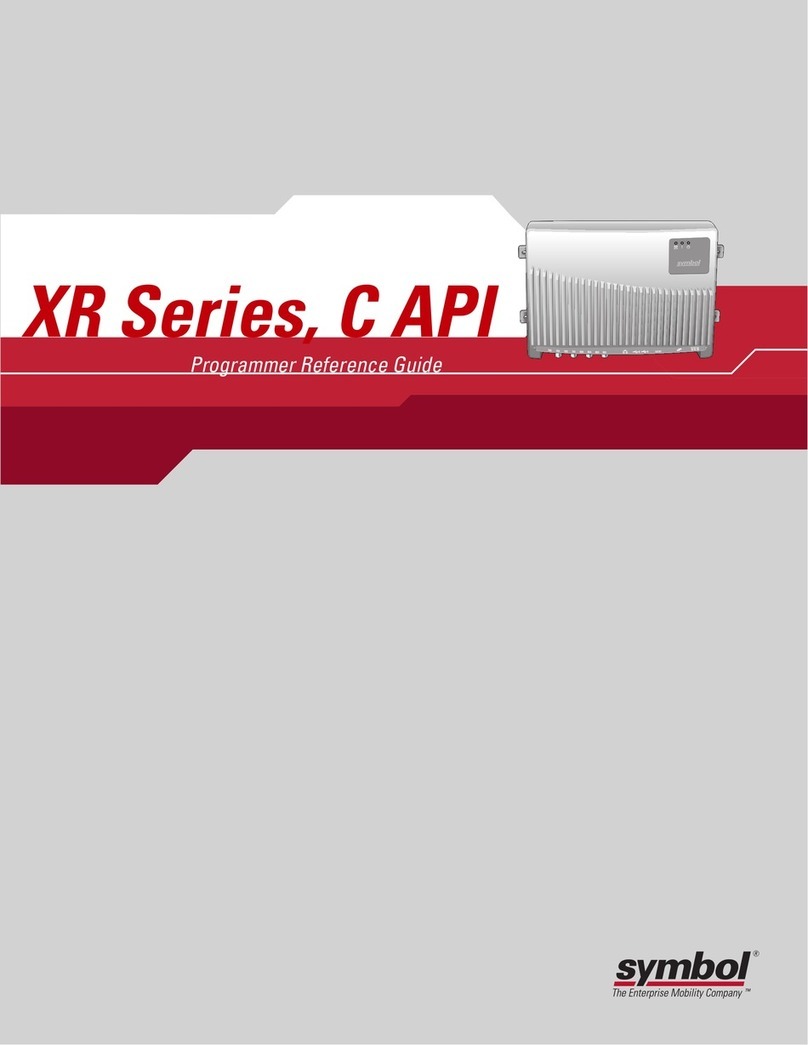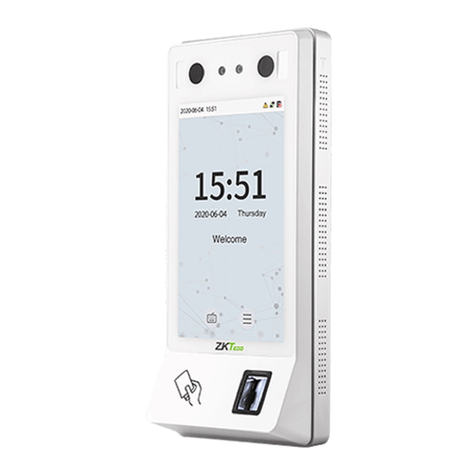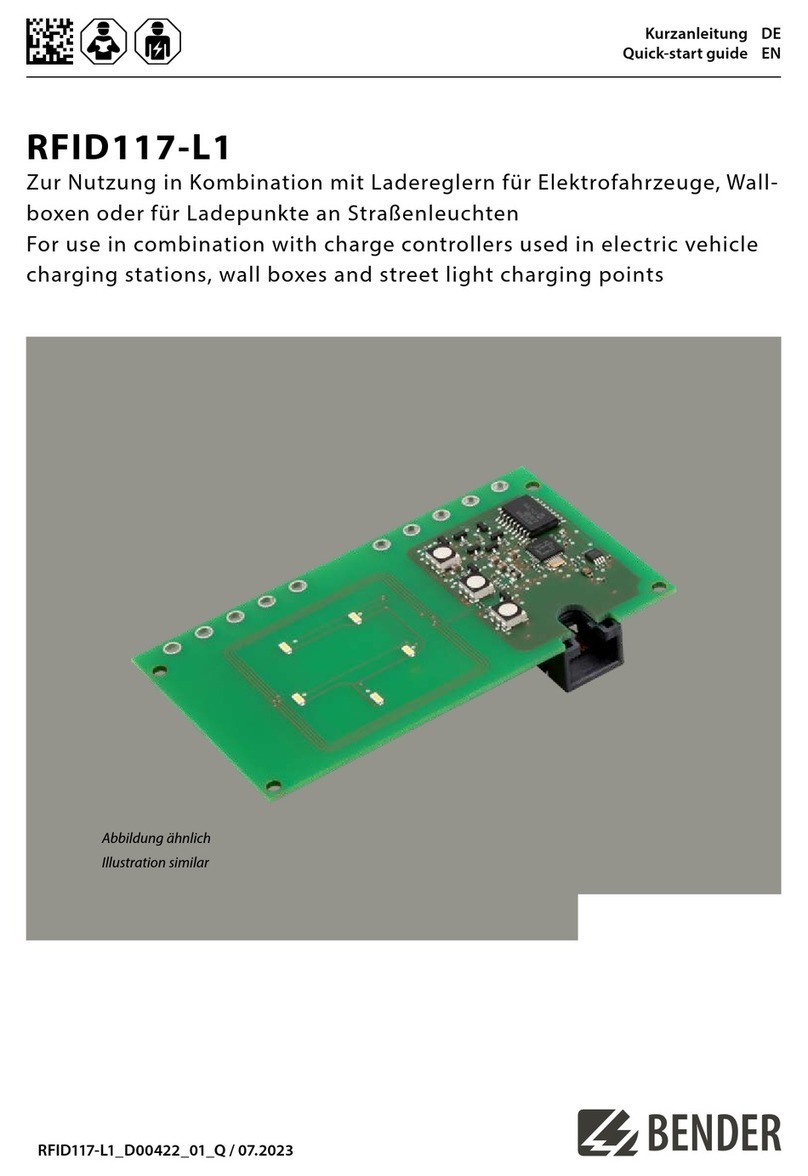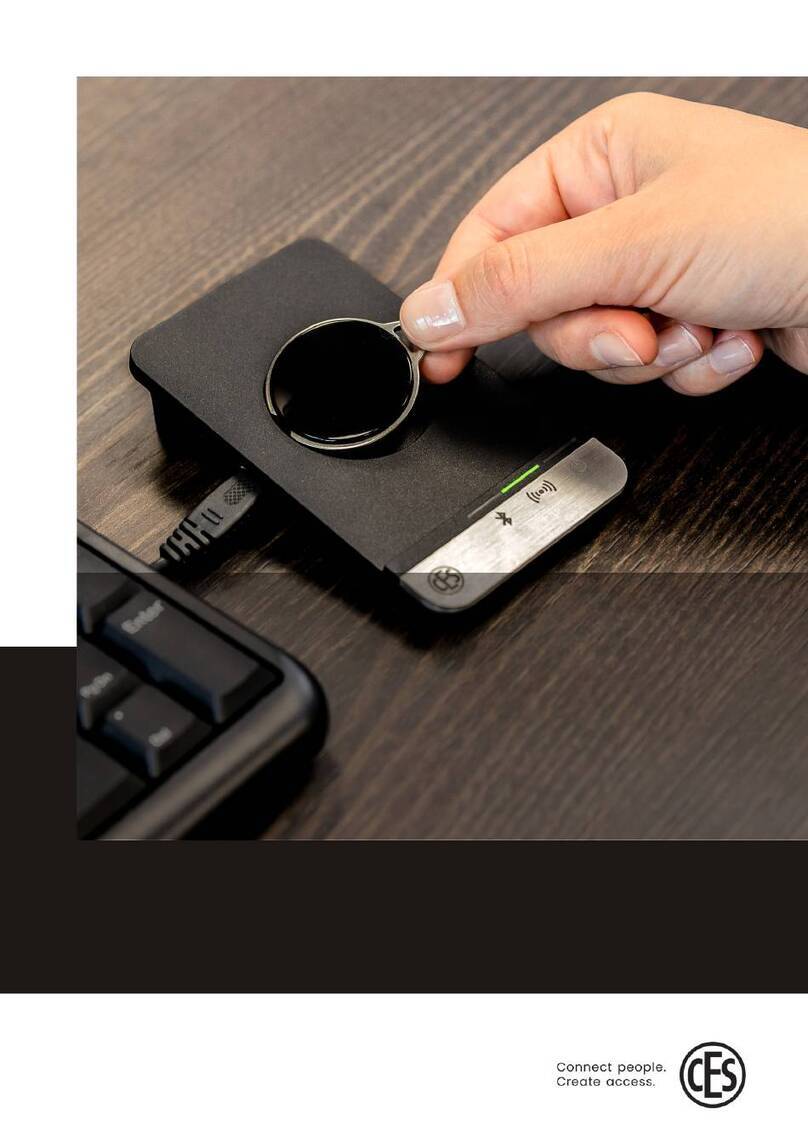TECH FASS MREM 77 EISGRT-MF User manual

MREM 77 EISGRT
Reader module 13,56 MHz, 125 kHz

Introduction
The MREM 77 EISGRT RFID reader module (13.56 MHz reader / dual reader 13.56 MHz
and 125 kHz) with integrated controller for one door control is designed either for
connection to the RS 485 bus of the APS mini Plus access system or for autonomous
operation. The module is also equipped with a Wiegand interface for connecting an input
RFID reader with a Wiegand output for possible double-sided controlled door. Up to 32
MREM 77 E reader modules can be connected to one RS 485 communication line of the
APS mini Plus system. The module can be covered with any standard cover intended for
the KU 68 installation box.
a. Application
▪Access control system, booking system
▪Door access control
b. Parameters
▪Input voltage 8 ÷ 28 Vdc
▪Typical current consumption 53 mA @ 12 V
▪Maximum input power 1,1 W
▪Reading id media MIFARE®, NFC, EM Marin, Jablotron
▪1x RS 485 (system bus APS mini Plus)
▪1x Wiegand (external RFID reader, GSM module, license plate camera) or next RS 485 (OEM)
▪1x Relay output 30 V / 2 A (lock)
▪2x INPUT (door contact, exit button, tamper)
▪1x Alert output (Alert notification)
▪1x I/O Port (Ext. tamper, reader module disabling –intruder alarm integration)
▪Assembly in the installation boxes KU 68, LK 80.
c. Variants
KATALOGUE NUMBER
PART NUMBER
SYSTEM
VARIANT
RFID frequency
534771A2
MREM 77 EISGRT-MF
APS mini Plus
KU 68-1901
13,56 MHz
53477311
MREM 77 EISGRT-EM
APS mini Plus
KU 68-1901
125 kHz
53477323
MREM 77 EISGRT
APS mini Plus
KU 68-1901
125 kHz, 13,56 MHz
53477412
MREM 77 FISGRT-MF
APS mini Plus
LK 80
13,56 MHz
53477401
MREM 77 FISGRT-EM
APS mini Plus
LK 80
125 kHz
534773F3
MREM 77 FISGRT
APS mini Plus
LK 80
125 kHz, 13,56 MHz
d. Marking
MIFARE®a MIFARE Classic®are registered trademarks, owned by NXP B.V.
Android®is registered trademark owned by Google LLC.

e. Block diagram
Full door control, standalone case
▪Bus system case with web control & administration

Content
1Technical parameters...............................................................................................5
1.1 Electrical parameters..................................................................................................5
1.2 Communication interface............................................................................................5
1.3 Mechanical parameters ..............................................................................................5
2Assembly...................................................................................................................6
2.1 Connection of MREM 77 E / F plug-able terminal block.............................................6
2.2 Installation instructions...............................................................................................7
3Wiring diagram .........................................................................................................8
3.1 Door control by RFID medium....................................................................................8
3.2 Connection of multiple modules .................................................................................8
4RFID reading .............................................................................................................9
4.1 Reading at 13,56 MHz................................................................................................9
4.2 Reading at 125 kHz..................................................................................................10
4.3 Dual reading at 13,56 MHz &125 kHz......................................................................10
5Settings ...................................................................................................................11
5.1 Setup procedure.......................................................................................................11
5.2 Meaning of the LED indicator...................................................................................12
5.3 Configurable parameters..........................................................................................13
6Operating modes....................................................................................................14
6.1 Standard operating mode.........................................................................................14
6.2 External reader with Wiegand output .......................................................................15
7Function ..................................................................................................................16
7.1 Functions of the reader module................................................................................16
7.2 Function ‘‘Door open‘‘...............................................................................................16
7.3 Permanent lock release based on valid time schedule ............................................16
7.4 Function of ID with flag.............................................................................................16
7.5 ID expiration .............................................................................................................16
7.6 Antipassback function (APB)....................................................................................17
7.7 Disabling the reader module.....................................................................................17
7.8Alerts and their signaling..........................................................................................17
7.9 Simplified access rights model .................................................................................19
7.10 Offline setting (programming) mode.........................................................................19
8Other........................................................................................................................23
8.1 Legislation ................................................................................................................23
8.2 Declaration of conformity..........................................................................................23
8.3 Electrical waste.........................................................................................................23

www.techfass.com RFID reader module MREM 77 5
1Technical parameters
1.1 Electrical parameters
PARAMETER
CONDITION
MIN
MAX
UNIT
Input voltage Vin
8
28
V
Typical current
consumption Iin
Vin = 8 V
Vin = 12 V
Vin = 24 V
75
53
30
mA
mA
mA
Peak current
consumption Iin
Vin = 8 V
Vin = 12 V
Vin = 24 V
106
73
42
mA
mA
mA
Typical input power
0,7
W
Maximum input power
1,1
W
Typical reading
distance (ISO card)
125 kHz (EM Marin)
3
5
cm
13,56 MHz (MIFARE®Classic®)
3
5
cm
RTC
Backup
24
h
Memory
ID media
Events
Time plans
2000
3400
64
pc
Signalization
RGB led
Piezo
1
1
pc
1.2 Communication interface
INTERFACE DESCRIPTION
TECHNOLOGY
PROPERTIES
System data bus
RS 485
19 200 bit / s, 8 data bits, even parity, 1 stop bit
Wiegand
Wiegand / RS 485
Formats 26, 32, 34, 37, 44, 46, 56 bits, custom
1.3 Mechanical parameters
PARAMETER
VALUE
UNIT
Weight
66
g
Dimensions D, h
D 73,5; h 43,5
mm
Mechanical mounting
Inside installation box KU68-1901
Or surface installation box LK 80
Colour
Grey
Material
Plastic
PVC
Environmental class
Indoor device general
Temperature range
-10 ÷ + 55
oC

www.techfass.com RFID reader module MREM 77 6
2Assembly
2.1 Connection of MREM 77 E / F plug-able terminal block
MREM 77 E orF includes 14pins plug-able screwable terminal block to connect all wires.
MREM 77 E / F ISGRT
NUMBER
TERMINAL DESCRIPTION
WHERE IT LEADS*
1
Input voltage Vin 8 ÷ 28 Vdc
Power supply
2
Power ground GND
Power supply
3
IN 1
Door contact
4
Signal ground 0 V
0 V
5
IN 2
Exit button
6
Port I/O 3
Intruder alarm sys
7
Alert output
Alert signalization
8
Wiegand W 0
WIO 22 / ext. reader
9
Wiegand W 1
WIO 22 / ext. reader
10
Signal A system data bus
device APS mini Plus
11
Signal B system data bus
device APS mini Plus
12
Relay contact C
+ 12 V / + 24 V
13
Relay contact N C
Not connected
14
Relay contact N O
Lock + 12 V / + 24 V
Example: The reader module is able to control the door standalone or as part of the APS mini Plus bus system. In addition to
the power supply, the module contains, 2 inputs, 1 input / output, alert output, wiegand input / output, RS 485 and relay.

www.techfass.com RFID reader module MREM 77 7
2.1.2 Inputs & Outputs
INPUT / OUTPUT
DESCRIPTION
Input 1 (IN 1)
Door contact, active when door closed; REX button
Input 2 (IN 2)
Request to exit button or handle contact, active when buttonor handle pressed; Tamper; Disabling
function
Output 1 (OUT 1)
Door lock control
Input / Output (IO 3)
Low power transistor output (+5 V in any alarm state)
2.2 Installation instructions
2.2.1 Reader module installation
The MREM 77 reader module is already assembled in the KU 68-1901 or LK 80 installation box. The reader module can
of course also be installed in already installed installation boxes in masonry (KU 68-1901), the attachment is made with
one screw. Standard UTP cables can be used, which, after connecting the detachable terminal block, fits well into the
remaining place in the installation box. If the UTP cable does not meet the power requirements of the controlled lock or
opener, it is of course necessary to use cable cores with an adequate cross-section according to the installation
parameters. Shorten the cable so that you are able to snap the detachable terminal block, but at the same time so that the
coiled cabling fits into the designated space in the installation box.
2.2.2 RS 485 bus termination
It is advisable to terminate the RS 485 system bus so that there is no reflection on the line. If this reader module is the
last one on the bus, it allows the termination to be done by its own jumper - a jumper, which connects the already fitted
termination resistor. By default, the termination resistor is disconnected.
2.2.3 RS 485 idle states
This reader module does not allow to set idle states of the system bus. Set the idle states on converters APSLAN or CON
110.IP if needed.
2.2.4 Radio signal interferences
If a 125 kHz reader is used, it is necessary to take into account another 125 kHz reader in direct range - for example when
checking the door on both sides. In this case, the readers may interfere with each other. In the techfass system, it is
possible to use the so-called synchronization of reading between the reader and the reading module, which then do not
interfere with each other.
In general, if possible, we avoid mounting on metal substrates, it is recommended to perform a practical reading test or
contact support@techfass.cz.
Interference along the line, e.g. from an interfering power supply, can affect the reading distance or the reader's own
communication.

www.techfass.com RFID reader module MREM 77 8
3Wiring diagram
3.1 Door control by RFID medium
The following figure shows the standard connection of the reader module. After a valid card or other medium is read by the
MREM 77 E reader module, this ID is evaluated directly by the MREM 77E module and, if valid, a relay is closed which
connects the power supply / control signal to the lock. The relay output can be configured in the control software to switch
standard, reverse or toggle, while setting the switching time.
Wiring diagram 1: Connection of one MREM 77 E reader module for control of one door. The module is also able to notify,
for example, a knocked out or door ajar on its AUX output.
3.2 Connection of multiple modules
It is possible to connect up to 32 modules to one line of the APS mini Plus system behind the APSLAN converter or
behind the cloud connector CON 110.IP. The lines can be further parallelized.
Wiring diagram 2: Up to 32 modules can be connected to one line of the APS mini Plus system and thus manage all doors
centrally. A REP 485 repeater can be used for star connection.

www.techfass.com RFID reader module MREM 77 9
4RFID reading
4.1 Reading at 13,56 MHz
The device can read media (cards, key fobs, stickers) according to ISO / IEC 14443A at the level of reading the so-called
UID. Examples of media technologies used are NFC and the MIFARE®product family. The device is also ready for so-
called sector reading, but it is not active yet.
Print screen from APS Reader application.
32 bit CSN
56 bit CSN
TF Mobile ID
Disabled
Disabled
Disabled
32 data bits (MSB)
32 data bits (MSB)
32 data bits (MSB)
32 data bits, reversed (LSB)
32 data bits, reversed (LSB)
32 data bits, reversed (LSB)
24 data bits (MSB)
24 data bits (MSB)
24 data bits (MSB)
Facility code 0x01 + 16 data bits
(MSB)
Facility code 0x01 + 16 data bits
(MSB)
Facility code 0x01 + 16 data bits
(MSB)
56 data bits (MSB)
56 data bits (MSB)
56 data bits, reversed (LSB)
56 data bits, reversed (LSB)
For the frequency 13,56 MHz, the format and length options of the so-called "card serial number" can be set according to
the table above. Similarly for the TF Mobile ID mobile application.
4.1.1 Identification by mobile phone with OS Android 4.4+
Mobile phones equipped with NFC technology, OS Android 4.4 Kit Kat (or higher) can be used for identification (replaces
the usual RFID card). You have to download TF Mobile ID application and follow its manual. The TF Mobile ID application
is available for free download on Google Play.

www.techfass.com RFID reader module MREM 77 10
The TF Mobile ID read format and length setting options are shown in the image above (print screen from APS Reader).
4.2 Reading at 125 kHz
The EM or dual variant of the device can also read media with a frequency of 125 kHz like EM Marin (e.g. EM4200,
EM4305). Next example of supported media technology is Jablotron ID.
125 kHz settings possibilities:
Default settings for 125 kHz.
4.3 Dual reading at 13,56 MHz &125 kHz
The dual variant of the device allows reading media according to 3.1 and 3.2 at the same time.
MIFARE®a MIFARE Classic®are registrated trade marks of NXP B.V.
Android®je registred trade mark of Google LLC.

www.techfass.com RFID reader module MREM 77 11
5Settings
5.1 Setup procedure
If we want to set the reader module MREM 77 E / F, e.g. its HW address or configure its parameters, we must connect it
to the computer and control software. Physical connection is possible using the device
via USB
APSUSB https://www.techfass.com/cs/produkty/102/produkt/1216/apsusb
via LAN
APSLAN https://www.techfass.com/cs/produkty/102/produkt/94/apslan
Alternatively, from anywhere with a web browser using
CON 110.IP https://www.techfass.com/cs/produkty/102/produkt/1628/con-110-ip
5.1.1 Software application
The desktop application for configuration
APS Reader https://www.techfass.com/cs/produkty/101/produkt/389/aps-reader
APS Hit https://www.techfass.com/cs/produkty/101/produkt/1355/aps-hit
The desktop application for administration
Small –medium installation: APS Hit https://www.techfass.com/cs/produkty/101/produkt/1355/aps-hit
Medium –large: APS Administrator https://www.techfass.com/en/products/101/product/391/aps-administrator
Web application for configuration & administration
WebHit https://webhit.techfass.com/login
5.1.2 HW address settings in APS Reader application
By MREM 77 E/FISGRT is possible to set HW address by software. The HW address can be set either in the desktop
program APS Reader or APS Hit or directly in WebHit (online service Cloud TECH FASS available via web browser).
5.1.3 HW address settings in APS Reader application
Step by step - If you know the serial number:
▪Connect wires A, B, GND to APSUSB, connect APSUSB to PC, start APS Reader
▪Select the required HW address
▪Select the option "Known serial number", enter the SN of your product
▪Press 'Connect' at the top of the blue menu
▪Press "Set" (the selected HW address is set)
▪Disconnect

www.techfass.com RFID reader module MREM 77 12
5.1.4 HW address settings in WebHit
▪Click on line configuration in the left menu
▪Click on set address with SN
▪Fill in the device SN and needed hw address
5.2 Meaning of the LED indicator
COLOUR
ACTION
DESCRIPTION
Red
Continuously lit
Flashing with a period of 4 s
Online communication of the RS 485 system bus
Offline operation
Green
Flash
ID media reading
Alternation
Red / green
Red / green flashing
Address setting mode /
RS 485 system bus test
Yellow
Continuously lit, flashing
Programming mode
Short flashing, period 1 s
Door lock release indication

www.techfass.com RFID reader module MREM 77 13
5.3 Configurable parameters
PARAMETER
SETTINGS OPTION
FACTORY SETTINGS
Max. output switching time*
0 ÷ 255 s
5 s
Acoustic signalization of lock release
YES / NO
YES
Type of lock output control (Polarity)
Direct / Reverse
Direct
Output mode (Lock control)
Standard / Change of state /
impulse
Standard
Permanent turn on of the output according to the
schedule
Never / Time schedule
Never
Yellow LED signalization of lock release
YES / NO
NO
Input 1
Door contact / exit button
Door contact
Input 2
Exit button
Handle contact
Tamper
Disable
Exit button
I / O port 3
Tamper
Disable
Tamper
ALERTS
Tamper (alert signalization time)
0 ÷ 255 s
0 s
Forced door (alert signalization time)
0 ÷ 255 s
0 s
Door ajar (alert signalization time)
0 ÷ 255 s
0 s
Door ajar (allowed opened door time)
0 ÷ 255 s
20 s
ID with Alarm flag (alert signalization time)
0 ÷ 255 s
0 s
Enable exit button in tamper state
YES / NO
YES
EVENTS
Events archive saving options
Door opened (input 1 off)
Door closed (input 1 on)
Input 2 off, input 2 on
Output 1 off, output 1 on
ON / OFF
ON / OFF
ON / OFF
ON / OFF
ON
ON
ON
ON
OTHER
Automatic conversion to CEST & back**
YES / NO
YES
Max. online response time by online authorization***
0 ÷ 25500 ms
800 ms
Authorize autonomously after response time exceeded
YES / NO
YES
* Valid for standard output mode (lock control). Not valid for change of state option.
** In WebHit, the time shift is done automatically according to the selected time zone.
*** Online authorization function is not available yet in WebHit.

www.techfass.com RFID reader module MREM 77 14
6Operating modes
There are two basic operating modes for the MREM 77 reader module.
▪Standard operating mode
▪External reader with wiegand output
6.1 Standard operating mode
Main operating mode. In this mode, the module acts as a controller for one door, reads RFID media and determines in its
memory whether or not the user should be authorized to enter and controls the lock output.
The module can be in online or offline standard operating mode. The function is identical in both modes, with the difference
that in the online mode, the module statuses are reported via the communication line (after changing the mode from offline
to online, the event archive is read from the module's memory). In both operating modes, the module can switch to
programming mode (after reading the programming card).
6.1.1 Offline mode
Offline, or autonomous / standalone mode. One module alone or more modules on the RS 485 bus, but without
connection to a PC. In this mode, events are stored in the module's internal memory, module authorizes users according
to the stored set access rights. Settings / configuration are performed by default using a PC or programming cards.
6.1.2 Online mode
In Online mode, the module or more modules on the line are connected to a PC running the relevant application such as
APS Hit or APS Administrator or the line is connected to the cloud using CON 110.IP and the administrator works in the
WebHit web application. In this case, each event is immediately written to the application.
6.1.3 Online authorization
The APS mini Plus system implements the option of Online authorization of access authorization. In such a use, the
connected PC decides on the validity of the read ID authorization. The reader must be MLO licensed to use it in this
authorization mode.
! Note: This feature is currently only available on desktop applications.
6.1.4 Secure lock control with WIO 22 module
The MREM 77 module itself contains a switching relay and there are connected wires to control the lock. In this simple
configuration, it is advisable to install the module in a safe zone, where we do not expect an attempt to overcome so that
someone will want to get to the cabling to control the lock. If we need the module to switch ‘‘ safely ‘‘, we connect the
WIO 22 module to its Wiegand output, we place WIO in a safe place, eg in a rack / cabinet or from the inside above the
door, from where it already controls the lock. The WIO module must first be paired with the MREM 77 reader module.
https://www.techfass.com/cs/produkty/102/produkt/402/wio-22

www.techfass.com RFID reader module MREM 77 15
6.2 External reader with Wiegand output
The MREM 77 reader module can be configured in external reader mode with Wiegand output in the following formats:
6.2.1 125 kHz
Enable / Disable options
▪Standard em marin & proprietary tf ID
▪Jablotron ID
*Default settings: All enabled.
ID length
125 kHz
bits
ID length
24
32
40
44
56
*Default settings: 40 bits format.
Wiegand output setting
125 kHz
bits
Data length
26
32
42
44
56
*Default settings: 42 bits format.
6.2.2 13,56 MHz
32 bit CSN
56 bit CSN
TF Mobile ID
Disable
Disable
Disable
32 data bits (MSB)
32 data bits (MSB)
32 data bits (MSB)
32 data bits, reversed (LSB)
32 data bits, reversed (LSB)
32 data bits, reversed (LSB)
24 data bits (MSB)
24 data bits (MSB)
24 data bits (MSB)
Facility code 0x01 + 16 data bits
(MSB)
Facility code 0x01 + 16 data bits
(MSB)
Facility code 0x01 + 16 data bits
(MSB)
56 data bits (MSB)
56 data bits (MSB)
56 data bits, reversed (LSB)
56 data bits, reversed (LSB)

www.techfass.com RFID reader module MREM 77 16
7Function
7.1 Functions of the reader module
▪Standard "Door open" function
▪Lock control
▪Door status monitoring
▪Exit button status monitoring
▪Activation of the alarm output / buzzer signaling when an alarm condition is indicated
The "Door open" function can be activated in three different ways
▪By reading a valid ID (card, key fob,…)
▪By pressing the exit button (depending on the configuration) - cannot be used during the alarm
▪Software, via communication line
7.2 Function ‘‘Door open‘‘
In the case of the standard lock control mode, after activating the "Door open" function, the release of the lock relay and
the buzzer are activated (unless disabled by configuration). This state lasts until the door is opened, but no longer than
the time set by the "Lock activation time" parameter. Then the lock output is deactivated and the standard function is
terminated.
In the case of the toggle lock control mode, after activating the "Door open" function, the relay output toggles and the
buzzer is activated (if it is not disabled by the configuration). The acoustic signaling lasts as set. The relay output remains
unchanged until the next activation of the "Door open" function.
In the case of the pulse lock control mode, after activating the "Door open" function, the relay output is activated for the
time given by the parameter Pulse width (ms).
In the case of the standard lock control mode, reading a valid card during lock activation will cause a new lock timing.
Online authorization
If the reader module reads the ID card during the "Door open" function via the communication line (in online mode) and if
the read ID is not valid, it is signaled by an acoustic signal "invalid ID" regardless of the configuration of the acoustic lock
release message.
7.3 Permanent lock release based on valid time schedule
When this function is set, the lock is permanently released during the validity of the respective schedule, the reading of a
valid ID is reported via the communication line (in online mode). When the lock is permanently released, the alarm state
of the forced door does not occur.
The setting of the permanent release of the lock according to the time schedule and the toggle lock control mode are
mutually exclusive.
7.4 Function of ID with flag
It is possible to set a flag for each ID, which will cause an alarm ‘‘ Alarm - ID with the flag ‘‘ when reading the appropriate
ID (and will activate the alarm output for a defined time).
7.5 ID expiration
It is possible to set a date for each ID at which the ID expires and will no longer be valid. The expiration is evaluated every
time the data in the RTC module changes and when new access rights are loaded.
! Note: This feature is currently only available on desktop applications.

www.techfass.com RFID reader module MREM 77 17
7.6 Antipassback function (APB)
Antipassback can be implemented in two ways:
▪Time - the user must not use the ID medium repeatedly for a defined time
▪Zone - the user must not repeatedly enter the area in which he is present
The antipassback function is used only for users who have defined access according to a schedule. The function does
not apply to users with permanently valid access.
Zone and time antipassback IDs can be reset by re-inserting the IDs using the programming cards. After reloading the
access rights by the program, the antipassback flags are reset for all IDs.
The zone and time antipassback flag is written according to the configuration either immediately after reading the ID, or
only after opening the relevant door (opening the relevant door contact).
7.6.1 Time antipassback
The time antipassback is defined by setting the duration (in minutes), which is set for the given ID when passing at the
given address. The next time the ID is identified at the relevant module address during the timer run for the given ID, a
time APB alarm is triggered. The following parameters affect the time antipassback function:
▪Default value of the APB timer - the time for which the APB timer alarm is triggered at the next ID identification,
the timer is set for the given ID when passing at the given address.
▪Enable door opening after time APB alarm - if the function is enabled, the Door opening function is started in
case of time APB alarm.
7.6.2 Zone antipassback
Zone antipassback is defined by enabling / disabling this feature. The zone antipassback flag is set for the user after
passing. Upon further identification, a Zone antipassback alarm is triggered in the case of a flag set for the given ID. The
following parameters affect the zone antipassback function:
▪Enabled - global enable / disable of the zone APB flag setting function.
▪Enable offline mode - if not set, the module works in offline mode as if the zone antipassback function was not
implemented at all.
▪Enable door opening after APB alarm - if the function is enabled, the Door opening function is started in case of
a zone APB alarm.
7.7 Disabling the reader module
Disabling of the reader module function can be configured on the second input or on the third I / O port of the module.
The function activation logic on each port is configurable. The function is activated if at least one of the ports is active and
set as disable.
The module in the disabled state exhibits the following behavior:
▪Users with set time schedule cannot trigger the door open function if it is disabled
▪Disable does not apply to the users with permanently valid access (no time schedule)
▪The remote door opening function cannot be performed
▪Remote door opening with ID is blocked for users with time schedule.
Changes in the status of the disable function and the blocked action are recorded in the event archive.
This function is useful for example in combination with intruder alarm system.
7.8 Alerts and their signaling
The following alert conditions may occur during the reader module operation:
1) Tamper.
2) Forced door.
3) Door ajar.
4) Antipassback alert (time, zone).
5) Alarm ID with flag.
To deactivate any alert, please set its value to “0”.
Alerts are reported as follows:
▪In software, by system bus (alerts 1, 2, 3, 4, 5)
▪Acoustic (alerts 1, 2, 3, 4)
▪Activating the alert output (alerts 1, 2, 3, 5)

www.techfass.com RFID reader module MREM 77 18
The alarm message via the communication line assumes an online connected PC with the appropriate software suitable
for online operation (APS Administrator).
The audible alert message is twofold:
▪Continuous tone (distortion)
▪Intermittent tone (knocked out and long open door, APB alarm)
The acoustic message ends either after the set time (see configuration table)
or after reading a valid ID on the relevant module.
When one of the relevant used alarm conditions occurs (signaling time
alarm must be greater than 0) the alarm output will be activated. On this output is
it is possible to connect the alarm device directly or to further process its signal.
The triggering of the alarm is controlled by a logical connection or between individual types
alarms.
The alarm condition is terminated by restoring all idle conditions (closing the door, fitting the cover, etc.).
7.8.1 Tamper
The MREM 77 E / F reader module is not equipped with a Tamper sensor to detect that the lid is open. This is due to the
variability of the covers that can be used with it. The module itself is ready for the connection of the tamper, for possible
installation it is necessary to share the intended cover and agree in advance by contacting suppo[email protected].
The "Violation" alarm state is generated by activating the Tamper signal by opening the cover of the reader module, or by
changing the state of the 2nd or 3rd input in the tamper configuration.
The Violation alarm state is evaluated only after the first idling state after switching on the reader module, if it is not
installed, there is no need to configure the module in any way.
7.8.2 Forced door
The "Forced door" status occurs when the IN1 input of the module is opened without first activating the "Door open"
function. The only exception is the exit button / handle contact signal activation from the inner side of the door.
7.8.3 Door ajar
The "Dopr ajar" status is activated by opening the door for a longer time than allowed (set), see the configuration table.
7.8.4 Antipassback alarm
Antipassback alarm is generated when a valid card is read at the time of blocking the user by Time APB,
or when the user is blocked by a Zone APB.
7.8.5 Alarm ID with flag
Alarm ID with a flag occurs when a card (ID) with flag is read.
7.8.6 Reading ID in time of alert
Reading a valid ID has no effect on the alarm conditions themselves. It is terminated with a valid ID
only an audible alarm, followed by the "door open" function. Reading an invalid ID only interrupts the audible alarm for the
duration of the "invalid ID" signaling.

www.techfass.com RFID reader module MREM 77 19
7.9 Simplified access rights model
The access rights model includes schedules and a holiday table. The block diagram for access evaluation is shown in the
following figure.
7.10Offline setting (programming) mode
For small simple autonomous installations, users can be set up using programming cards. The module enters the
programming mode by reading one of the pair of programming cards ("+" and "-" cards). It does not enter the
programming mode while waiting for the card confirming the address setting (for modules with address setting via the
communication line). The behavior of the modules in the programming mode is evident from Fig. 5 a-d.
When inserting cards using programming cards, it is not possible to work with time schedules, so the cards are still valid.
7.10.1 Inserting cards (ID codes) into the memory
Follow these steps for inserting cards into the reader module’s memory:
Step 1
Step 2
Step 3
Read the programming card
for inserting: the reader goes
into programming mode.
One by one, read the cards
which are to be granted
access.
About 15 seconds after
inserting the last card the
reader module goes back
into standard operating
mode.
VALID
UNKNOWN
ID FOUND
ACCESS DRIVEN
BY TIME SCHED.
ACCESS ALWAYS
GRANTED
HOLIDAY?
ACCESS GRANTED
FOR HOLIDAY
AND ACTUAL TIME
ACCESS GRANTED
FOR ACTUAL
DAY & TIME
READING ID
YES
NO
YES
NO
NO
YES
INVALID
YES
NO
NO
YES
NO
YES

www.techfass.com RFID reader module MREM 77 20
Pic.5 a): Inserting cards
7.10.2 Deleting cards from the reader’s memory
For deleting the cards from the reader module’s memory use following steps:
Step 1
Step 2
Step 3
Read the programming card
for deleting: the reader goes
into programming mode.
One by one, read the cards
which are to have their
access revoked.
About 15 seconds after
deleting the last card the
reader module goes back
into standard operating
mode.
Pic.5 b): Deleting cards
7.10.3 Deleting cards „above or below“
If a user loses his ID medium, it is usually impossible to delete the ID from the memory with the procedure described in
the previous chapter, since the medium is no longer available (with an exception of entering the code at the keypad).
Following procedure can be used for deleting such ID. The procedure requires using an ID medium, which was inserted
right before or right after the ID medium, which should be deleted.
Step 1
Step 2
Step 3
Read the programming card
for inserting: the reader goes
into programming mode,
which is indicated by slow
flashing of yellow LED.
Read the programming card
for inserting 5 times in a row;
the reader will go into
Deleting cards “above or
below” mode indicated by fast
flashing of yellow LED.
Read a card, which is located
in the module’s memory right
before or right after the card
you wish to delete. After this
step the module quickly
flashes with yellow LED
Step 4 - A
Step 4 - B
Step 5
For deleting an ID located
right before the ID used in
precious step, read the
programming card for
deleting.
For deleting an ID located
right after the ID used in
precious step, read the
programming card for
inserting.
The reader module goes back
into standard operating
mode.
Pic.5 c): Deleting cards “above or below”
This manual suits for next models
11
Table of contents
Other TECH FASS RFID System manuals

